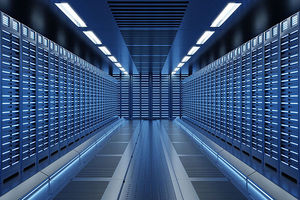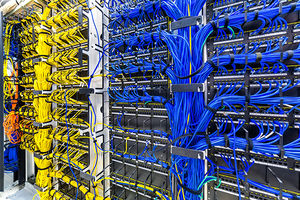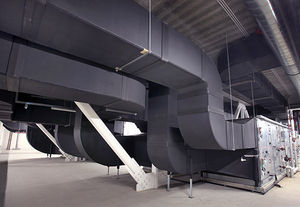 If our global society is using more and more data, then we can assume that we must be using more and more energy, right? Not so, says a comprehensive new analysis. Researchers at Northwestern University, Lawrence Berkeley National Laboratory, and Koomey Analytics have developed a detailed model of global data center energy usage. With this model, researchers found that although demand for data has increased rapidly, massive efficiency gains by data centers have kept energy use roughly flat over the past decade. This detailed, comprehensive model provides a more nuanced view of data center energy use and its drivers, enabling the researchers to make strategic policy recommendations for better managing energy use in the future.
If our global society is using more and more data, then we can assume that we must be using more and more energy, right? Not so, says a comprehensive new analysis. Researchers at Northwestern University, Lawrence Berkeley National Laboratory, and Koomey Analytics have developed a detailed model of global data center energy usage. With this model, researchers found that although demand for data has increased rapidly, massive efficiency gains by data centers have kept energy use roughly flat over the past decade. This detailed, comprehensive model provides a more nuanced view of data center energy use and its drivers, enabling the researchers to make strategic policy recommendations for better managing energy use in the future.
Even with this new information, IT industry professionals still have room for improvements as there is more than enough remaining efficiency potential to work on for several more years. The increased demand for data means that everyone — including policy makers, data center operators, equipment manufacturers and data consumers — must intensify efforts to avoid increased energy use later this decade.
 "Considering that data centers are energy-intensive enterprises in a rapidly evolving industry, we do need to analyze them rigorously,” said study co-author Arman Shehabi, a research scientist at Lawrence Berkeley National Laboratory. “Less detailed analyses have predicted rapid growth in data center energy use, but without fully considering the historical efficiency progress made by the industry. When we include that missing piece, a different picture of our digital lifestyles emerges.”
"Considering that data centers are energy-intensive enterprises in a rapidly evolving industry, we do need to analyze them rigorously,” said study co-author Arman Shehabi, a research scientist at Lawrence Berkeley National Laboratory. “Less detailed analyses have predicted rapid growth in data center energy use, but without fully considering the historical efficiency progress made by the industry. When we include that missing piece, a different picture of our digital lifestyles emerges.”
To paint this picture, researchers integrated new forms of data such as information on data center equipment stocks, efficiency trends, and market structure. The resulting model enabled a detailed analysis of energy use by type of equipment (such as servers, storage devices and cooling systems), by type of data center (including cloud and hyperscale centers) and by regional location.
The researchers concluded that recent efficiency gains made by data centers have likely been far greater than those observed in other major sectors of the global economy. By releasing the model, the team hopes to inspire more research into the topic and help develop policies that mitigate future growth in energy use.
Insulation for Information Management
 Even with energy use efficiency growth, there are systems that data center managers can implement to reduce energy use and waste even further. Armacell’s ArmaFlex® closed-cell foam insulation is a rubber-based flexible material ideal for insulating cooling systems with ducts, chilled water piping, chillers, tanks and air handlers. Insulating pipes, refrigeration lines or cooling systems not only promotes energy efficiency, but it also prevents condensation on below-ambient temperature surfaces—a critical issue for data center management.
Even with energy use efficiency growth, there are systems that data center managers can implement to reduce energy use and waste even further. Armacell’s ArmaFlex® closed-cell foam insulation is a rubber-based flexible material ideal for insulating cooling systems with ducts, chilled water piping, chillers, tanks and air handlers. Insulating pipes, refrigeration lines or cooling systems not only promotes energy efficiency, but it also prevents condensation on below-ambient temperature surfaces—a critical issue for data center management.  Armacell also uses a fiber-free, formaldehyde-free, low VOC formulation for its foam insulation, which makes it an excellent option for the data center environment, eliminating particulates that can damage sensitive servers. Its closed-cell structure also prevents moisture ingress and naturally resists growth of mold and mildew, helping protect indoor air quality. The flexible nature of elastomeric insulation means it installs easily in tight spaces in floors, walls or ceilings. You can count on ArmaFlex insulation retaining its thermal integrity over time, lasting well into the digital age.
Armacell also uses a fiber-free, formaldehyde-free, low VOC formulation for its foam insulation, which makes it an excellent option for the data center environment, eliminating particulates that can damage sensitive servers. Its closed-cell structure also prevents moisture ingress and naturally resists growth of mold and mildew, helping protect indoor air quality. The flexible nature of elastomeric insulation means it installs easily in tight spaces in floors, walls or ceilings. You can count on ArmaFlex insulation retaining its thermal integrity over time, lasting well into the digital age.
To read the full article, please visit: https://news.northwestern.edu/stories/2020/02/data-centers-use-less-energy-than-you-think/
